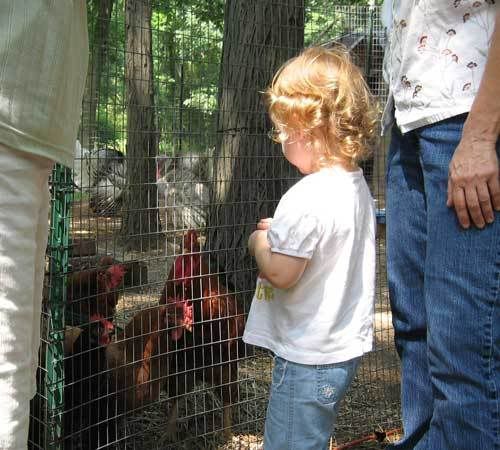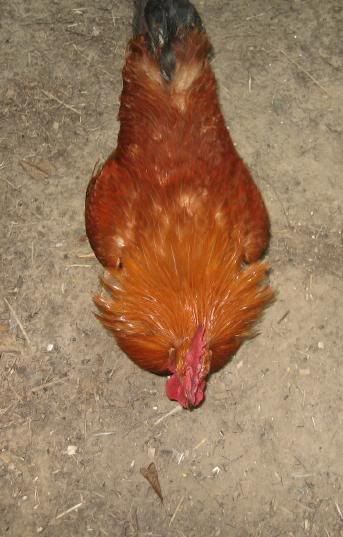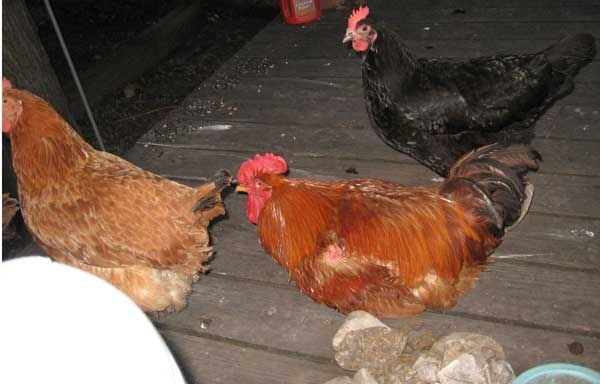At 20 weeks of age a cockerel's testosterone level is starting to climb rapidly. He is beginning to measure the extent of, and to look for ways to expand, his dominance while exercising his prerogatives. He doesn't know `antagonizing' from antinomy (he just lives it). Your son(s) are seen as threats to the safety/control of the flock, or as wayward members of the flock that need to be kicked into line. There are no peace offerings (food/treat source). He will just as likely drop the treat, give out with the `tidbitting' call to the girls and then jump to flog the owner of the hand that just passed him the goody. One of the signs that a cockerel/roo is trying to control you is his standing nearby and engaging in sham `tidbitting', i.e., picking up dead grass/gravel/etc. and tossing it to one side or the other with his beak (not making the tidbitting call, just closing the gap until WHAM). Almost as if he's saying `yo ma hen, now get in the car, hen' (at this point ours finds himself riding on my forearm like so much pigskin, laced, and knotted up, by the humiliation of it all).
A rattlesnake is more predictable than a roo. Rattlers usually strike if one wanders into their `space', they do not pretend to ignore you then circle around and sneak up from behind to `lay on the fangs'. Roos will `seem' to be foraging around in the run, as you bend over to change out the water, so as to get a better shot at your face. They will appear to be innocently involved in ranging with the hens. as you walk past (hands empty), on the way get some straw and wood chips for the coop, timing the subsequent bushwhacking of the backs of your legs to the moment your hands are full `can't grab me this time, human!' WHAM!
Our roo is an average example. New, or unusual stimuli can set him off (new pair of mudboots with a yellow layer of rubbber above the sole he just had to attack - took about a week before he adjusted), he is wary and watchful of us most of the time and takes good care of his hens. He is not fond of being picked up and carried around every time he decides to test our dominance. Standard roos are easy to grab when they saunter up, put their head down signalng the challenge by `unfurling' the hackles:
Bend over, knees locked and hands down just like a toe touching exercise, quickly place one hand on the roo's back and the other on a wing, slide the hand on back down on the opposite wing, grab him up, flip him around lengthwise and, if done properly, he will then be tucked up under one arm like a football. Take the hand that's free and move it toward the roo's face like a traffic cop giving the Stop signal - roos can't get a good grip on a flat palm with their beak. Massage his wattles and tell him what a good guy he is (ours hates that). I might have to cycle through this pattern three times before he realizes his hens have moved off into the garden; he'll stand there shifting from one foot to the other, working the odds, before giving out with his growly whine and off he goes. This is usually all it takes and he pretty much ignores or tolerates us for several weeks before trying to advance to alpha again.
The only SURE way to avoid unpredictable injuries and difficult to answer questions in the ER:

When to pick up, or, if not so inclined, apply the BROOM, or the breading... - I'd go with demonstrating to him, again, the `joys' of perfect submission
 :
:

On reaching an `understanding' our roo takes it easy and lets the _____ mammal sitting on the deck steps do predator duty:

A how-to guide on avoiding a`spurious' peckng order: http://shilala.homestead.com/roosters.html
ED: Get a pair of mudboots and wear them ONLY in the backyard (good to prevent spur bruises from standard roos - Bantam Roos? not so much, as someone mentioned one flying up into their face while they were on a ladder! - also the separate footwear/`shin guard' is good biosecurity measure)
ed: clarity/`gwamma'
A rattlesnake is more predictable than a roo. Rattlers usually strike if one wanders into their `space', they do not pretend to ignore you then circle around and sneak up from behind to `lay on the fangs'. Roos will `seem' to be foraging around in the run, as you bend over to change out the water, so as to get a better shot at your face. They will appear to be innocently involved in ranging with the hens. as you walk past (hands empty), on the way get some straw and wood chips for the coop, timing the subsequent bushwhacking of the backs of your legs to the moment your hands are full `can't grab me this time, human!' WHAM!
Our roo is an average example. New, or unusual stimuli can set him off (new pair of mudboots with a yellow layer of rubbber above the sole he just had to attack - took about a week before he adjusted), he is wary and watchful of us most of the time and takes good care of his hens. He is not fond of being picked up and carried around every time he decides to test our dominance. Standard roos are easy to grab when they saunter up, put their head down signalng the challenge by `unfurling' the hackles:
Bend over, knees locked and hands down just like a toe touching exercise, quickly place one hand on the roo's back and the other on a wing, slide the hand on back down on the opposite wing, grab him up, flip him around lengthwise and, if done properly, he will then be tucked up under one arm like a football. Take the hand that's free and move it toward the roo's face like a traffic cop giving the Stop signal - roos can't get a good grip on a flat palm with their beak. Massage his wattles and tell him what a good guy he is (ours hates that). I might have to cycle through this pattern three times before he realizes his hens have moved off into the garden; he'll stand there shifting from one foot to the other, working the odds, before giving out with his growly whine and off he goes. This is usually all it takes and he pretty much ignores or tolerates us for several weeks before trying to advance to alpha again.
The only SURE way to avoid unpredictable injuries and difficult to answer questions in the ER:

When to pick up, or, if not so inclined, apply the BROOM, or the breading... - I'd go with demonstrating to him, again, the `joys' of perfect submission


On reaching an `understanding' our roo takes it easy and lets the _____ mammal sitting on the deck steps do predator duty:

A how-to guide on avoiding a`spurious' peckng order: http://shilala.homestead.com/roosters.html
ED: Get a pair of mudboots and wear them ONLY in the backyard (good to prevent spur bruises from standard roos - Bantam Roos? not so much, as someone mentioned one flying up into their face while they were on a ladder! - also the separate footwear/`shin guard' is good biosecurity measure)
ed: clarity/`gwamma'
Last edited:





